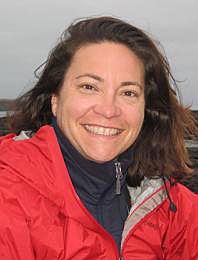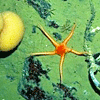As the world’s oceans grow more acidic from increased absorption of atmospheric carbon dioxide, marine scientists are confronting a key question: How well can organisms like mollusks, crustaceans, and corals adapt to these more corrosive conditions? One of the leading authorities in this field is University of California, Santa Barbara marine biologist Gretchen Hofmann. Her work in recent years has shown, in fact, that some sea organisms that build shells do seem to have some ability to acclimate to more acidic waters.

But in an interview with Yale Environment 360 contributor Elizabeth Grossman, Hofmann cautions that this adaptive capacity has its limits and that the continuing burning of fossil fuels could push ocean acidity past a tipping point, rendering some mollusks and other organisms unable to construct shells. Studying sea urchins and other creatures from California to Antarctica, Hofmann and her laboratory are examining the genetic changes that enable marine life to adapt to more hostile ocean conditions, including acidic waters and higher temperatures. Hofmann says her research also is seeking to identify regions of the global oceans that could serve as refuges for shell-building marine life as the seas become more acidic.
Yale Environment 360: Could you talk about your current research and why what happens to marine species as oceans become more acidic is important beyond the world of marine science?
Gretchen Hofmann: The biggest-picture component we’re interested in is whether organisms and populations can adapt to coming environmental changes. This is an important question for lots of different reasons and species, whether you’re talking about plants or fish. As the environment rapidly changes, we may be outstripping the physiological and biological capacity of today’s organisms to tolerate tomorrow’s conditions. And so our research addresses that issue specifically: What is the adaptive capacity of marine organisms in the face of a rapidly changing ocean?
The second thing we’re doing is trying to look at things together, at
multiple factors changing at the same time — pH changing as temperature changes. We’re trying to more accurately look at these environmental complexities.
e360: How are marine species responding specifically to ocean acidification? Is there any evidence that they will be able to change in ways that allow them to thrive under these changing conditions?
Hofmann: Some of the work that we’ve been doing in the lab directly addresses the question: Can organisms adapt? Can evolutionary adaptation respond to ocean acidification? Mostly working with marine invertebrates like the sea urchin, what we’ve found is that there are populations of sea urchins on the West Coast that appear to have the genetic diversity to, at least right now, respond to acidic conditions in the ocean.
“What is the adaptive capacity of marine organisms in the face of a rapidly changing ocean?”
To answer this question you have to step back and think about the fact that organisms are adapted to the environment that they live in. The specific oceanography of the West Coast of the U.S. has a process we call upwelling, where winds blow off the ocean and bring deep, cold, CO2-rich water up. That water is low pH [more acidic] water. With the sensors we’ve had out, we’ve learned over time that this really acidic water is bathing the organisms near shore. So to some extent over a pretty long period of time these organisms have gotten used to low pH water. There’s probably some [natural] selection going on.
We’ve started examining that and found that in northern California, where waters tend to have more upwelling, these organisms have a different genetic profile than those elsewhere — than those in southern California — and the parents are able to confer that genetics to their babies. So the progeny that have fathers from the north tend to be tougher in the face of low pH conditions. So it matters who your daddy is in these things.
“Some organisms have the capacity to adapt, but as a biologist you have to ask yourself, ‘How far can they go?’”
So in some ways evolution can buy us time, we think. Some organisms have the capacity to adapt, but as a biologist you have to ask yourself, “How far can they go?” We don’t know if this adaptive capacity can be sustained in low pH water for really long periods of time. Evolution can come to the rescue but probably can’t go on forever. You can say these organisms have responded to the changing environment because they’re used to a variable environment, but some of the biology they do, like calcification [to form shells], is dependent on the chemistry of what’s in the water and it’s unlikely that they can adapt their way out of not having water that doesn’t support calcification anymore. I think evolution buys us time. How much, we don’t know.
e360: Can you tell us why you’ve also been working in Antarctica?
Hofmann: The reason we’re studying the Antarctic is because the water is so cold it holds a lot of CO2 and it’s probably the most vulnerable to low pH effects of future acidification. So we’ve been working down there through the United States Antarctic Program. Part of what I did when I started working in this area is that I chose organisms that I thought would help us answer basic questions, but also started focusing on ecosystems that we wanted to prioritize. We felt there were ecosystems that the climate modelers told us would be first in time to experience ecologically deleterious conditions, and so we chose Antarctica and the West Coast of the U.S.
e360: Are we on what seems like an unstoppable course of continuing ocean acidification?
Hofmann: We have some committed climate change to face. We’ve committed to these technologies for releasing CO2 into the atmosphere and have a certain amount of CO2 increase that we’re going to have to deal with until we change the way we do business. There are a lot of engineering solutions that people are looking at right now, but geo-engineering solutions to change the pH of the ocean just are not going to apply. There’s not enough baking soda in the world to dump into the water to change things.
But there are some management things we can consider. We can look at coastal ecosystems, for example, that are hit by multiple stressors. Coral reefs are affected by environmental impacts like ocean acidification, but also by inputs from the land. So as humans we can try to make decisions to make life as good for these ecosystems as we go through this period of anthropogenic change. That’s going to require a lot of will on our part as community members, humans, and decision-makers.
The other thing — and as scientists we always say this — but we need more information. One of the things we’re learning is about natural variation: what the pH and carbonate chemistry is like around different reefs and along the California coast. This tells us a couple of very important things.
“There’s not enough baking soda in the world to dump into the water to change things.”
If we find a place with lots of natural variation we might say that is an adaptation hotspot, so we might want to study and protect that place because the organisms there are already evolving the genes to adapt. Alternatively, we might learn that there are places that don’t change that much and where the pH is really great and the calcification is really happy, so that we need to preserve that place as a calcification reserve or refuge from future stressors as a safe harbor.
This comes down to humans having the will to get the information and having the will to act.
e360: Why do these changes matter to life on land?
Hofmann: I’m from the middle of the country. I grew up in Wyoming and Colorado so I really understand that question. First, the microscopic plants, the phytoplankton in the ocean, create about half of the oxygen that we use on this planet, just with their own metabolism. So the ocean is directly tied to the quality of our atmosphere.
MORE FROM YALE e360
Scientists Focus on Polar Waters As Threat of Acidification Grows

The second thing that’s really important is food security. As we watch these changes around the planet, we know that lots of things can happen biologically. One of the things we know is that there will be changes in food webs. There can be big losses with fish in the ocean not having their food sources, so that a particular fishery doesn’t do as well and isn’t available to us anymore. There may be a slow degradation, but it could also be that populations will come to a tipping point where there is a cataclysmic change in the biology and ecology of that species so that their reproduction fails, and they migrate away and they’re just gone.
There’s also the valuing of nature, valuing the beautiful ocean wilderness we have on all coasts of the United States. In the same way we value the Grand Canyon and Yosemite National Park or Yellowstone, we should think of these ocean wildernesses and protect them.
e360: What else should we be thinking about in terms of this research?
Hofmann: One of the things I really stress is the future generations of scientists we need to train. I work with a lot of undergraduates, and their future planet has got some problems, but they’re inspired to do the hard work to understand what’s happening to the planet and try to preserve it. So the human and science capital is critical.